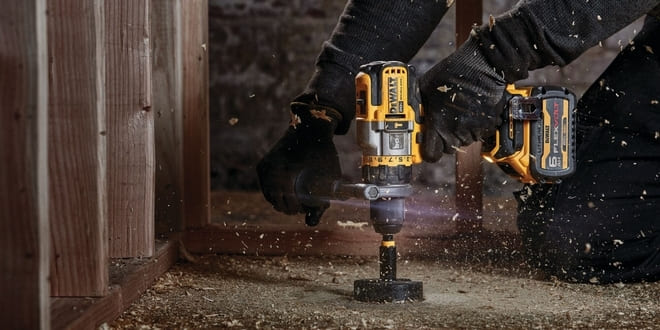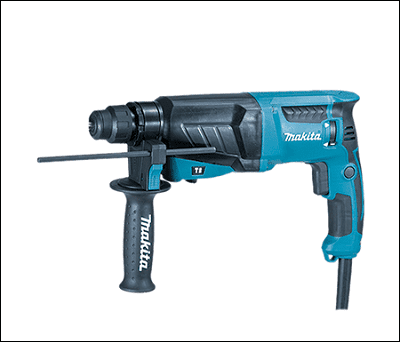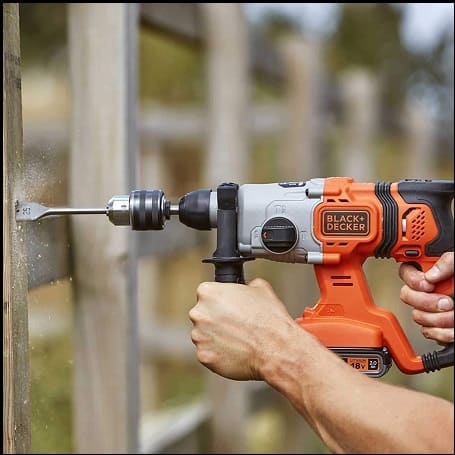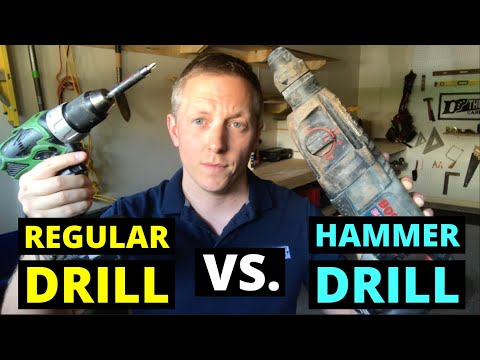
A hammer drill, commonly referred to as percussion or impact drill, is an essential tool for any toolbox for drilling on hard surfaces.
You may use hammer drills in jobs requiring great force to make a penetration. If you are wondering what a hammer drill does, the model withstands wear from any strong surface it drills through, making it stronger than other ordinary drills.
Notably, a hammer drill is the best tool to choose when creating holes through hard surfaces, including bricks, stone, concrete, and tile.
Working on hard surfaces includes separating ceramic tiles or creating holes in concrete walls and floors. Additionally, you may use the tool to drive screws or tighten nuts.
Uses of A Hammer Drill
Pinning concrete wall forms on concrete footings
Concrete or stone includes hard materials that make up walls of houses and tanks.
Using ordinary drills to bore holes through concrete walls is challenging since it consumes much energy and time.
Notably, a hammer drill quickly penetrates concrete and stone, making work more accessible.
The model is the best choice for drilling tasks so that pinning the frame is easy.
Separating ceramic tiles
Separating tiles manually or by using any ordinary drilling tool could be hectic. A hammer drill quickly penetrates through tiles, making separation easy. Notably, a hammer drill would be your best choice when you need to replace floor tiles since it efficiently separates them.
Mounting objects on walls
Electricians use a hammer drill to fix electric or meter boxes on walls. The tool quickly penetrates through wood studs or stone walls.
It would help if you needed to disable and enable the hammer when penetrating through masonry walls to penetrate through the wood. Additionally, to mount a screen on a stone wall, you use a hammer drill to boreholes.
Insertion of wall framings on concrete floors
You may need to have your floor decorated with wall framings. A hammer drill is the best tool to bore holes in the concrete floor to ensure easy pinning of the wall framings.
Driving screws through surfaces
There are hammer drills in which you may turn the impact mechanism. In those cases, the object will work well in tightening screws or bolts on a surface.
An example is tightening the screw or nuts of a socket mounted on a wall. However, a screwdriver may use a hammer drill when no drilling is taking place.
Hammer drills without a trappable impact mechanism are the best for driving screws. The drilling mode is standardized, which applies to most hammer drills today. Additionally, electric screwdrivers are available in the market and consume less power.
Benefits of a Hammer Drill

Different hammers in the market have modifications for proper functioning and completing projects efficiently. There are various benefits to acquiring the best hammer.
The device may penetrate any surface.
A hammer drill overtakes the ordinary drill, which only penetrates soft surfaces. An ordinary drill will not penetrate through stone or concrete, which a hammer drill does with ease.
Hammer drills make mounting anything, even on hard surfaces, easy for users. Notably, fixing a bookshelf on a brick wall is easy when using a hammer drill.
It serves two purposes at a time.
A hammer drill saves customers the trouble of buying a screwdriver and a drill simultaneously. A setting on the hammer drills turns off the hammer function, making it possible to tighten nuts or screws.
The tool does what a cordless drill would have done, saving you money since you do not need to purchase the two at once. A hammer drill performs both drilling and screwdriver at the same time.
Quick at handling large screws
A hammer drill has excellent power to get tough jobs done easily. Therefore, it is the best tool for great woodwork projects. Building a bookshelf requires large screws. However, the hammer drill quickly tightens large screws using less effort from the user.
One hammer drill accepts different drill bits.
Hammer drills have an adjustable chuck that holds the drill during the drilling process. Therefore, using different sizes of bits is possible, depending on the hole you want to drill.
Saves energy when drilling
The impact created in the drilling process produces enough force to drive. Additionally, the rotating force created during the drill makes the task faster and more efficient.
A large screw saves the user from exerting a lot of force and energy. Therefore, drilling is accessible no matter how hard the surface seems since the hammer drill produces a great penetration force.
The model saves time.
A hammer drill does not take longer to penetrate a hard surface than an ordinary drill. The user completes the task in a short period. Additionally, the model requires less energy to operate, minimizing user fatigue.
The Working Principle of a Hammer Drill
Hammer drills power in two ways, including percussion and electro-pneumatic power. The percussion hammer drill operates under two gear series that interact with each other.
Strong discs ride over each other and produce the hammering movement. The gears series give a combined effort, resulting in rotation of the drill bit while at the same time hammering it forward.
Using electro-pneumatic power is the second method of getting a hammer drill to work. It mainly applies to rotary drill hammers, also called EP hammer drills. Powering takes place through a combination of electricity and pressurized air.
Electric power rotates the crank, resulting in the drive piston’s movement. Pressurized air creates a cushion between the two pistons, giving the hammer drills its pulverization power.
Top FAQ
Why would you use a hammer drill?
The main reason to use a hammer drill is for drilling into hard, dense materials like concrete, brick, or stone. The hammering action drives the drill bit deeper into tough masonry materials than a regular drill can.
This makes hammer drills ideal for concrete drilling, installing masonry anchors, drilling holes in brick or stone for attachments, and similar heavy-duty tasks.
Can I use a hammer drill as a regular drill?
Yes, hammer drills can also be used for regular drilling in wood, plastic, and light metals. Most have a setting to turn off the hammering action and utilize the rotation.
However, hammer drills tend to be heavier and have lower maximum speeds than traditional ones so they won’t work as well for lighter tasks.
Is a hammer drill the same as an impact drill?
No. Hammer drills use a hammering action along with rotation. Impact drills utilize concussive, sudden impacts to drive the bit, but do not rotate. The impacts provide the power, while rotation is minimal. Hammer drills rotate constantly like a regular drill, but add hammering.
Is a hammer drill better than a regular drill?
For heavy-duty masonry drilling, yes – the hammering mechanism makes a hammer drill much more powerful than a standard drill.
But for lighter tasks, basic household/DIY drilling, or projects with wood, plastic, or light metal, a regular drill is often better.
Hammer drills are heavier, run at lower RPMs, and their hammering action is unnecessary for lighter materials. Consider the work you need to do, and choose the best tool.
What does a hammer drill do vs a regular drill?
Hammer drills use impact power and rotation to penetrate rigid materials, while regular drills rely solely on rotation and are better suited for lighter drilling applications.
Final Thought
A hammer drill is a crucial tool when you have it at hand. The model resists wear and tear, giving you long-lasting service. Accordingly, purchasing one is the best choice, especially when working on hard surfaces.
Additionally, the device consumes less and less energy than an ordinary drill or any other equipment. Therefore, customers should visit our websites and study more about what a hammer drill does to avoid later inconveniences.

